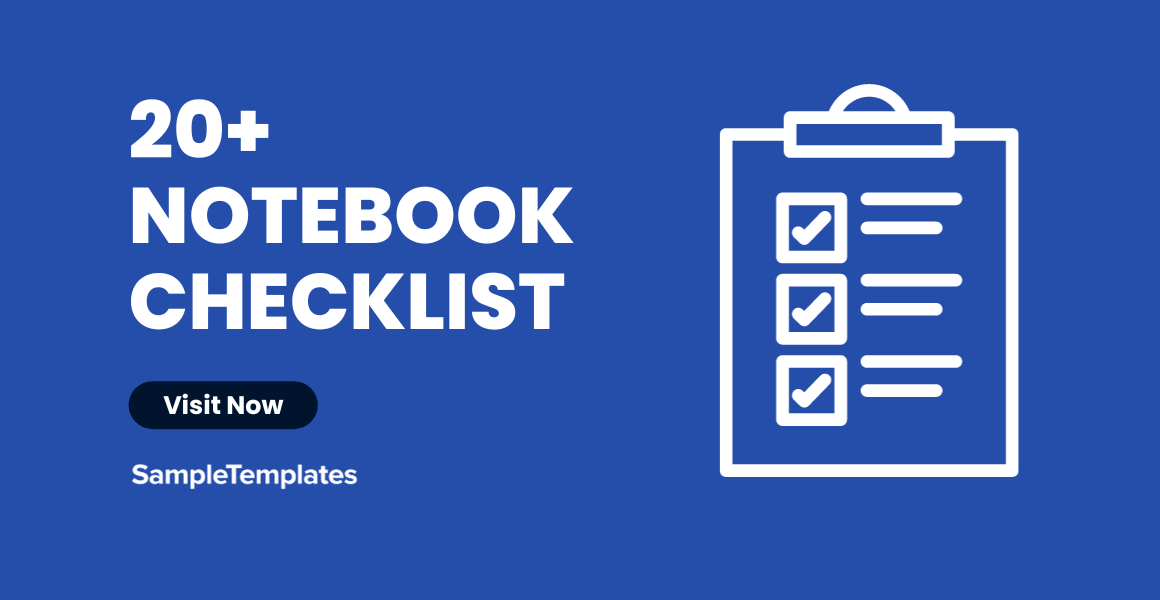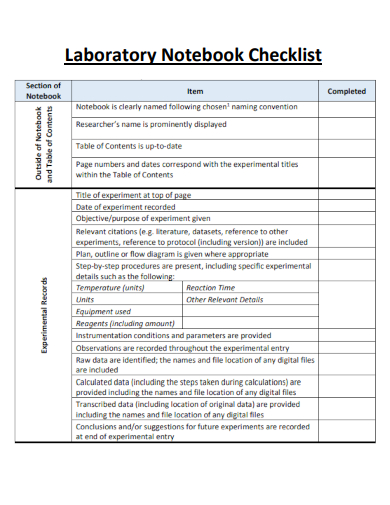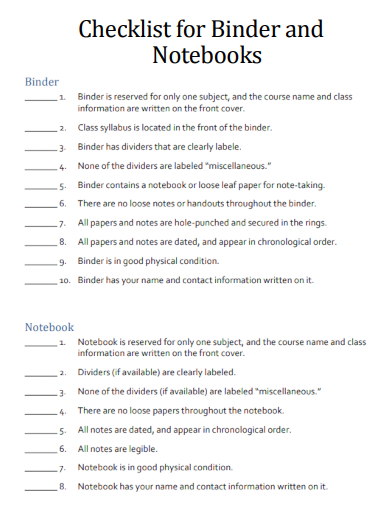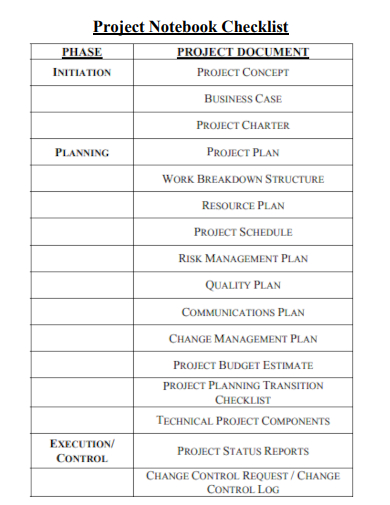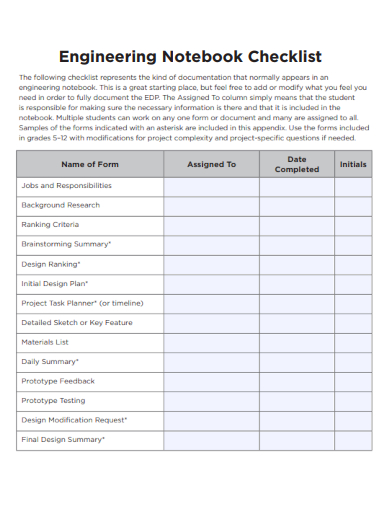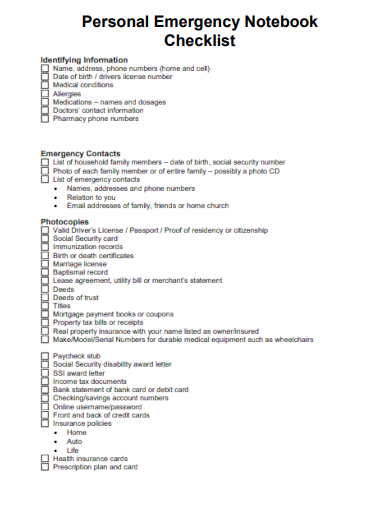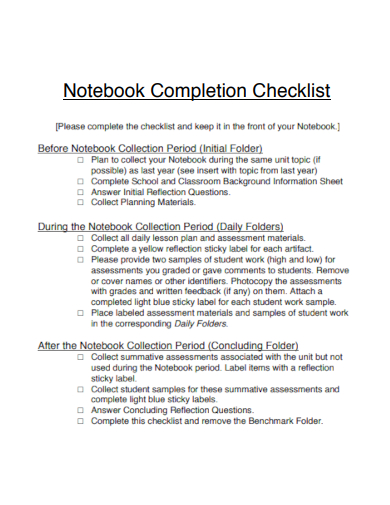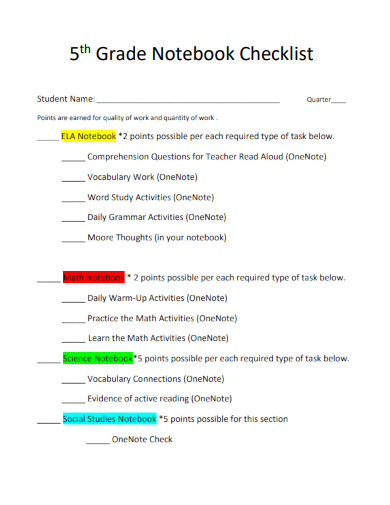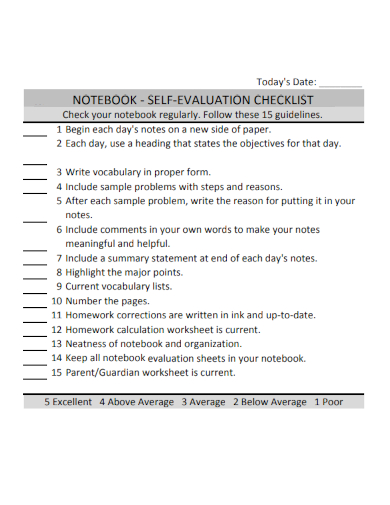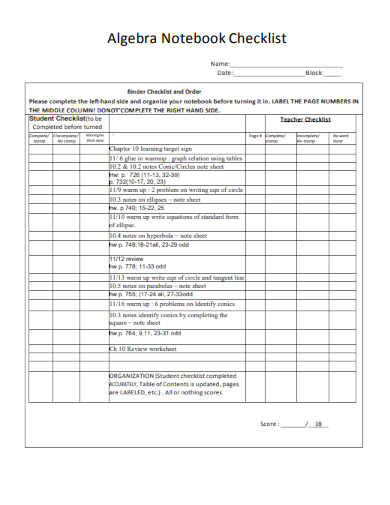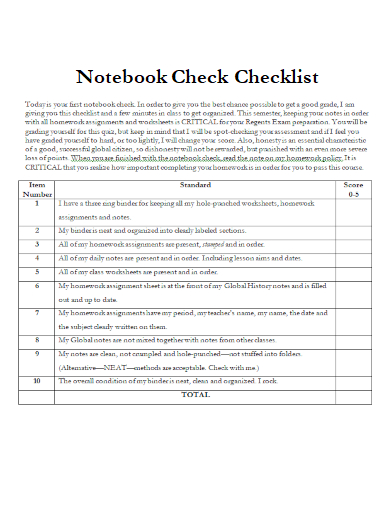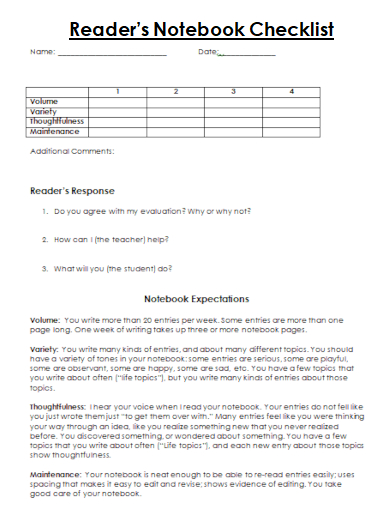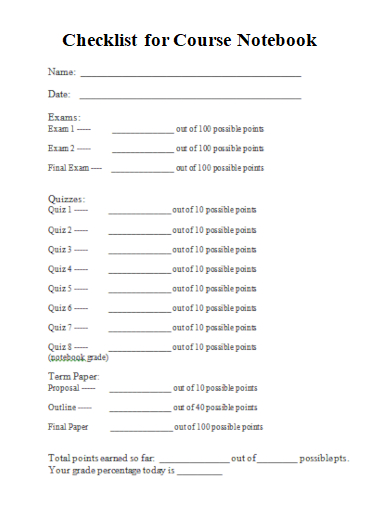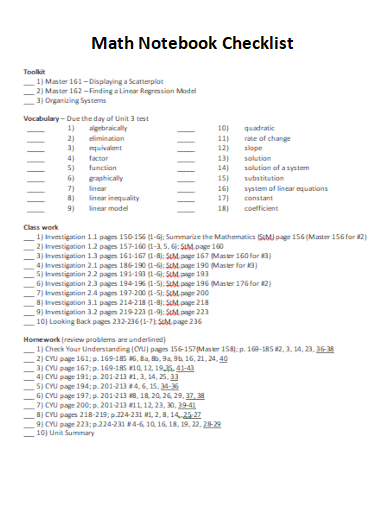In today’s digital era, the timeless charm of physical notebooks remains unparalleled. Whether you’re a student, professional, or journaling enthusiast, the right notebook can elevate your writing experience. Our ‘Notebook Checklist’ delves deep into the must-have features, ensuring you pick the perfect one for your needs. From paper quality to binding durability, we cover every facet. Before you invest in your next notebook, make this checklist your go-to guide.
FREE 20+ Notebook Checklist Samples
1. Sample Notebook Checklist Template
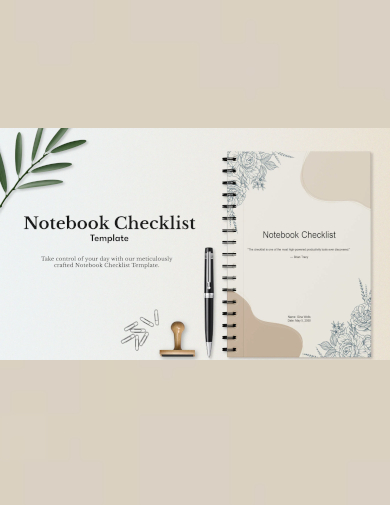
2. Sample Checklist Template
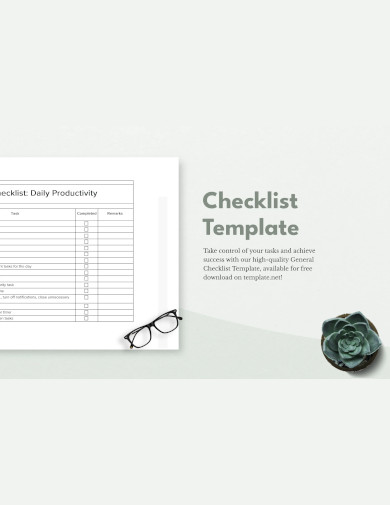
3. Basic Checklist Template
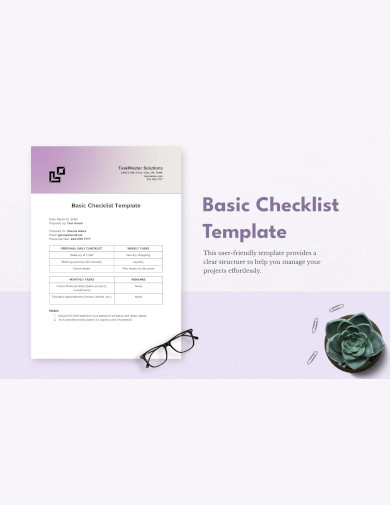
4. Formal Checklist Template
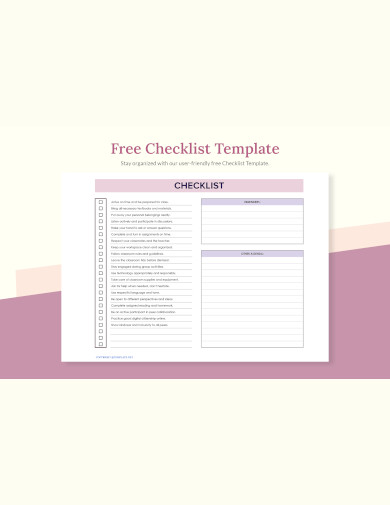
5. Printable Checklist Template
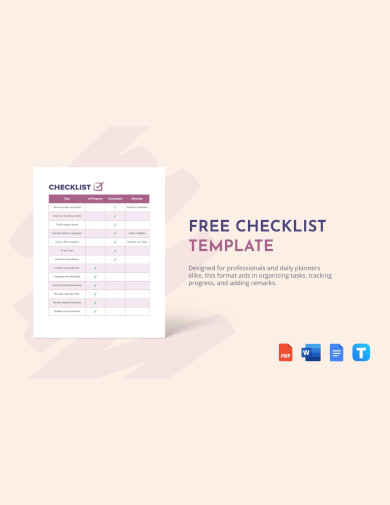
What is a Notebook Checklist?
A Notebook Checklist is a guideline or a set of criteria used by individuals to determine the most suitable notebook for their needs. Whether you’re a student, professional, artist, or just someone who loves to jot down thoughts, the right notebook can make all the difference. But with countless options available, it’s essential to know what to look for.
At its core, a Notebook Checklist is meant to help users:
- Define Purpose: Understanding the primary use of the notebook is crucial. Are you using it for journaling, academic note-taking, artistic sketches, or business meetings?
- Assess Cover Quality: The durability and appeal of the notebook often start with its cover. Do you need a rugged cover for field notes or a more elegant one for professional settings?
- Check Binding Type: The way pages are bound affects usability. Spiral bindings might lay flat easily, whereas stitched or glued bindings offer a more traditional book-like feel.
- Evaluate Paper Quality: The thickness and texture of the paper can influence the writing experience. For instance, fountain pen users might prefer thicker paper to prevent ink bleed-through.
- Choose Page Layout: There are various layouts available – lined, dotted, blank, or gridded. Your preference will depend on whether you’re writing, drawing, or creating sample charts.
- Look for Special Features: Some notebooks come with extras like bookmarks, pockets, elastic closures, or even pre-numbered pages. These can be beneficial depending on how you intend to use the notebook.
- Consider Environmental Factors: With growing environmental concerns, many people prefer notebooks made from recycled materials or sourced from sustainable forests.
- Size and Portability: The dimensions of the notebook matter, especially if you’re carrying it around. A pocket-sized notebook is great for on-the-go notes, while larger ones might be more apt for detailed note-taking.
- Price and Brand: Depending on personal preferences and budget, some might opt for luxury brands, while others might look for functional, cost-effective options.
Understanding the Notebook’s Purpose
Before diving into what should be on your notebook checklist, it’s essential to define its intended purpose. Are you a student taking lecture notes, an artist sketching ideas, or a professional jotting down meeting minutes? The intended use significantly influences the attributes you should seek.
Cover Quality and Durability
A notebook’s cover isn’t just about aesthetics. It provides the first line of defense against wear and tear. Depending on where and how often you’ll be using your notebook, you might opt for a hardcover for extra protection or a softcover for flexibility and a lighter carry.
Type of Binding
The binding of a notebook determines how well it will lay flat and its overall durability. Spiral-bound notebooks can lie completely flat and are easy to fold, while stitched or glued bindings offer a more traditional look and feel.
Paper Quality
Arguably the most crucial aspect of a notebook, the paper quality, will determine your writing experience. If you use fountain pens, thicker, bleed-proof pages are a must. On the other hand, pencil enthusiasts might prefer a slightly textured surface for better graphite adherence.
Page Layout
Notebooks come in various page layouts: lined, dotted, blank, or gridded. Your choice should align with your primary activities. For instance, artists might gravitate towards blank sheet pages, while writers might favor lined ones.
Special Features
Modern notebooks often come with additional features like built-in bookmarks, back pockets, page numbers, or pre-printed index pages. Consider which of these might be beneficial for your needs.
How do you Maintain a Notebook Checklist?
Maintaining a notebook checklist is about ensuring that the criteria you’ve established for selecting a notebook remain up-to-date and relevant to your needs. This is especially important if you often buy notebooks or if your requirements change over time. Here’s a step-by-step guide on how to maintain a notebook checklist:
- Review Regularly: Set aside time (maybe once every few months or annually) to revisit your simple checklist. This will help you ensure it still aligns with your current preferences and needs.
- Assess Usage: Look back at the notebooks you’ve used recently. Which features did you use and appreciate the most? Which ones were lacking or unnecessary? Your observations can guide updates to your checklist.
- Stay Informed: New types of notebooks, paper qualities, and innovative features are introduced to the market regularly. By staying informed about these changes, you can adjust your checklist accordingly.
- Gather Feedback: Talk to other notebook enthusiasts or colleagues. They might share insights or preferences you haven’t considered, which can be added to your checklist.
- Prioritize: As your checklist grows, it’s essential to prioritize items. Identify which aspects are non-negotiable (like paper quality for a fountain pen user) and which ones are flexible preferences.
- Organize: A well-structured checklist is easier to maintain and use. Group similar items together, such as paper-related criteria (quality, layout, perforation) and cover-related criteria (material, durability, design).
6. Sample Laboratory Notebook Checklist Template
7. Sample Checklist for Binder and Notebooks Template
8. Sample Project Notebook Checklist Template
9. Sample Engineering Notebook Checklist Template
10. Sample Personal Emergency Notebook Checklist Template
11. Sample Physics Lab Notebook Checklist Template
12. Sample Notebook Completion Checklist Template
13. Sample 5th Grade Notebook Checklist Template
14. Sample Notebook Self-Evaluation Checklist Template
15. Sample Algebra Notebook Checklist Template
16. Sample Notebook Check Checklist Template
17. Sample Readers Notebook Checklist Template
18. Sample Checklist for Course Notebook Template
19. Sample Notebook Vocabulary Checklist Template
20. Sample Go-Bag Notebook Checklist Template
21. Sample Math Notebook Checklist Template
How do you Create a Notebook Checklist?
A notebook checklist is an invaluable tool for organization and productivity. Whether you’re a student, professional, or someone looking to manage day-to-day tasks better, having a well-organized checklist in your notebook can be your guidepost. Here’s a step-by-step guide to creating an effective notebook printable checklist.
1. Identify Your Purpose
Before diving into the creation process, take a moment to identify the purpose of your checklist. Are you tracking daily tasks? Preparing for an exam? Organizing a project? Your purpose will dictate the format, layout, and contents of your checklist document. For instance, if you’re preparing for an exam, your checklist might be subject-specific, breaking down study topics and resources.
2. Choose a Suitable Notebook
Your choice of notebook is more crucial than it might seem. For a checklist, you’d ideally want a notebook that can lay flat, making it easier to view your sample list and check off tasks. A notebook with lined or dotted pages can help keep your printable list neat. Additionally, consider the size: a pocket-sized notebook is portable but might be too small if you have extensive tasks, while a larger notebook offers ample space but might be less convenient to carry around.
3. Create a Template
Establish a consistent layout or template for your checklist. This might include:
- Title: Clearly label what the checklist covers, e.g., “Weekly Tasks” or “Project Milestones.”
- Date: Especially for daily or weekly checklists, marking the date helps track progress over time.
- Columns: You might have one for tasks, another for deadlines, and a third for ticking off completed tasks. Consider using symbols such as checkboxes, circles, or dashes to represent tasks.
4. Populate Your List
Start filling in your tasks:
- Be Specific: Instead of writing “Study,” specify “Study Chapter 4 of the Biology textbook.”
- Break Down Larger Tasks: Instead of “Complete project,” break it down into “Research topic,” “Draft outline,” “Write introduction,” and so on.
- Set Deadlines: Where applicable, set a deadline or timeframe for tasks. This provides a sense of urgency and can aid in prioritization.
5. Review and Prioritize
Once all tasks are listed, review and prioritize. You can:
- Number Tasks: Indicate their order of importance or the sequence in which they should be tackled.
- Use Colors: Color-coded tasks based on urgency, type, or any criteria you find helpful. For instance, red for urgent tasks, blue for study-related tasks, and green for personal chores.
- Allocate Time: For tasks that might be time-consuming, allocate a specific amount of time. For example, “Research topic – 2 hours.”
In Conclusion, Notebook checklist samples provide a structured approach to maintaining organization and efficiency in note-taking. By using these templates, users can ensure that they capture essential information, maintain consistency, and enhance their productivity. These samples are indispensable tools for anyone seeking to optimize their notebook-keeping practices.
Related Posts
A Checklist: When Should You Fire an Employee [ With Samples ]
FREE 20+ College Application Checklist Samples in MS Word ...
FREE 20+ Evaluation Checklist Samples in PDF MS Word
FREE 33+ Incident Checklist Samples in PDF MS Word
FREE 35+ Checklist Form Samples in MS Word Google Docs ...
FREE 29+ Building Checklist Samples in Google Docs MS Word ...
FREE 20+ Volunteer Checklist Samples in PDF MS Word
FREE 16+ Project Checklist Samples & Templates in Excel PDF ...
FREE 16+ Schedule Checklist Samples in PDF MS Word
FREE 10+ Travel Journal Samples in PDF MS Word
How to Create a Checklist [ With Samples ]
FREE 33+ Verification Checklist Samples in PDF MS Word
FREE 51+ Study Checklist Samples in MS Word Google Docs ...
FREE 33+ Departure Checklist Samples in PDF MS Word
FREE 17+ Daily Checklist Samples & Templates in PDF MS Word ...
